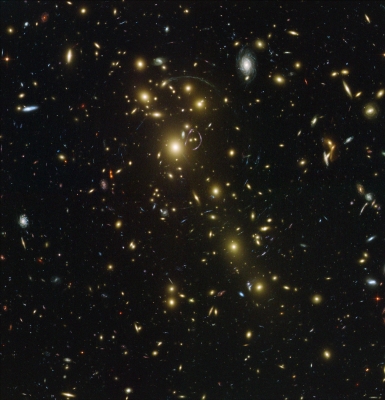 Like a newborn's foggy vision slowly coming into focus, the Hubble Space Telescope has enabled humanity to see more clearly than ever before the world beyond our noses, a cosmos of contradictions: incandescent and quiescent, violent and benevolent, chaotic and orderly.
Like a newborn's foggy vision slowly coming into focus, the Hubble Space Telescope has enabled humanity to see more clearly than ever before the world beyond our noses, a cosmos of contradictions: incandescent and quiescent, violent and benevolent, chaotic and orderly.
From developing an instrument that allows Hubble to point precisely at cosmic targets to discovering the farthest known galaxy, The University of Texas at Austin has been a big player in humanity's awakening vision of the cosmos. Here are ten discoveries related to Hubble Space Telescope:
1. Farthest Galaxy (2013) Steven Finkelstein led a team that discovered and measured the distance to the most distant galaxy ever found.
2. How Early Galaxies Grew (2012) Research by Tim Weinzirl and Shardha Jogee suggested that galaxy mergers aren't the primary way that galaxies in the early universe grew.
3. 'Out Of Whack' Planetary System (2010) A team led by Barbara McArthur discovered a planetary system in which the orbits of two planets are at a steep angle to each other.
4. Medium-Size Black Hole (2008) Karl Gebhardt was part of a team that discovered evidence of a medium-size black hole at the center of a nearby star cluster.
5. Improved Cosmic Ruler (2007) A team led by Fritz Benedict and Barbara McArthur improved on an existing technique for measuring the distances to stars and galaxies, which is useful for measuring the universe's age, rate of expansion and other properties.
6. Mysterious Disk of Blue Stars (2005) John Kormendy and other astronomers discovered a mysterious disk of blue stars orbiting very close to a supermassive black hole in the Andromeda Galaxy.
7. Weighing an Extrasolar Planet (2002) Fritz Benedict and Barbara McArthur made observations that led to a precise measurement of the weight of an extrasolar planet orbiting a red dwarf star.
8. New Class of Black Holes (2002) Karl Gebhardt was part of a team that discovered the first two examples of a new class of black holes, medium-size black holes, which are much heavier than those created by the collapse of a single huge star but much smaller than those supermassive ones in the cores of most galaxies.
9. Pointing the Way (1998) Fritz Benedict and Bill Jefferys led a team developing the Hubble Telescope's Fine Guidance Sensors, which allow it to point precisely at cosmic targets.
10. Jupiter-Sized Planet? (1993) Fritz Benedict was part of a team that discovered a wobble in our closest star, Proxima Centauri, which could have meant the presence of a Jupiter-sized planet, but which turned out not to be the case.
Click here to see Hubble's Top 100 Images (by RocketSTEM), including #62 above, summarized by Dr. Steven Finkelstein.

















Comments 4
GREAT material to read. I've loved astronomy since my childhood. Used to listen to Stardate, , LOVE reading books on this stuff., , Honestly, still wondering about the concept of black holes, The graphic pictorials used in most documentaries about them are far from convincing for me.
#10 got it backwards. We determined that there was NO Jupiter-sized planet orbiting Proxima Centauri.
Thanks for catching that Fritz. I've corrected it.
I started star watching at 10-11 y.o. on my back in winter snows in WNY winter skies always seemed to be clearer, went on to earn couple of merit badges on my way to becoming an Eagle Scout. Bilt a 6" reflector 'scope in H.S.with help (much) from my father who did the machineing of metal parts,3 bros and a Physics teacher and dzs, of students who helped grind the lens.Joined USAF at 18 commissioned a 2nd LT at 19,and did instruction in Celestial navigation as a navigator in B-52s. traveled all over the world and have never found any thing close to the beauty of the night sky.My first sailboat was called Canopus and the 2nd was Southern Cross